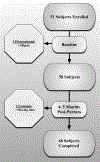Pregnancy Results in Lasting Changes in Knee Joint Laxity
- PMID: 29964215
- PMCID: PMC6320712
- DOI: 10.1016/j.pmrj.2018.06.012
Pregnancy Results in Lasting Changes in Knee Joint Laxity
Abstract
Background: Altered joint laxity can contribute to joint dysfunction. Knee joint laxity has been shown to increase during pregnancy, but its long-term persistence is unknown.
Objective: To determine whether pregnancy leads to lasting increases in knee joint compliance and laxity that persist longer than 4 months postpartum.
Design: Prospective cohort study.
Setting: A motion analysis laboratory at an academic medical center.
Participants: Fifty healthy women in their first trimester of pregnancy (mean ± SD 29.2 ± 4.3 years old and baseline body mass index 26.0 ± 5.4 kg/m2 ) were recruited.
Intervention: End-range knee laxity and midrange joint compliance were measured during the first trimester and 19 ± 4 weeks postpartum. Anterior-posterior and varus-valgus laxity were measured using 3-dimensional motion tracking while applying forces and moments in each respective plane using the Vermont Knee Laxity Device. Nonlinear models were constructed to assess relations between applied forces and joint translation, comparing early pregnancy with postpartum.
Outcomes: Multiplanar knee laxity and compliance.
Results: Peak varus-valgus (20-22%; P = .001) and posterior translation (51%; P < .001) of the tibia relative to the femur decreased from baseline, with a concomitant decrease in laxity (P < .001) and compliance (P = .039) in the coronal plane and in the posterior direction in primiparous (P = .009) and multiparous (P = .014) women. For primiparous women, laxity (P < .001) and compliance (P = .009) increased in the anterior direction.
Conclusions: Pregnancy resulted in a lasting decrease in multiplanar knee laxity and compliance in the varus and posterior directions with an increase in anterior compliance. The effects of these changes in laxity and compliance of the passive stabilizers on knee loading patterns, articular contact stresses, and risk for osteoarthritis and other musculoskeletal disorders will require additional research.
Level of evidence: II.
© 2018 American Academy of Physical Medicine and Rehabilitation.
Figures





Similar articles
-
Anterior cruciate ligament-deficient patients with passive knee joint laxity have a decreased range of anterior-posterior motion during active movements.Am J Sports Med. 2013 May;41(5):1051-7. doi: 10.1177/0363546513480465. Epub 2013 Mar 14. Am J Sports Med. 2013. PMID: 23492824
-
Changes in fatigue, multiplanar knee laxity, and landing biomechanics during intermittent exercise.J Athl Train. 2015 May;50(5):486-97. doi: 10.4085/1062-6050-49.5.08. Epub 2015 Feb 12. J Athl Train. 2015. PMID: 25674926 Free PMC article.
-
Raising the Joint Line in TKA is Associated With Mid-flexion Laxity: A Study in Cadaver Knees.Clin Orthop Relat Res. 2018 Mar;476(3):601-611. doi: 10.1007/s11999.0000000000000067. Clin Orthop Relat Res. 2018. PMID: 29443845 Free PMC article.
-
Association of malalignment, muscular dysfunction, proprioception, laxity and abnormal joint loading with tibiofemoral knee osteoarthritis - a systematic review and meta-analysis.BMC Musculoskelet Disord. 2018 Jul 28;19(1):273. doi: 10.1186/s12891-018-2202-8. BMC Musculoskelet Disord. 2018. PMID: 30055600 Free PMC article.
-
Tibiofemoral Osteoarthritis and Varus-Valgus Laxity.J Knee Surg. 2017 Jun;30(5):440-451. doi: 10.1055/s-0036-1592149. Epub 2016 Sep 28. J Knee Surg. 2017. PMID: 27680888 Free PMC article. Review.
Cited by
-
Suitable Heel Height, a Potential Method for Musculoskeletal Problems during the Third Trimester: A Pilot Study.Bioengineering (Basel). 2024 Jun 29;11(7):667. doi: 10.3390/bioengineering11070667. Bioengineering (Basel). 2024. PMID: 39061749 Free PMC article.
-
Osteoarthritis as an Umbrella Term for Different Subsets of Humans Undergoing Joint Degeneration: The Need to Address the Differences to Develop Effective Conservative Treatments and Prevention Strategies.Int J Mol Sci. 2022 Dec 6;23(23):15365. doi: 10.3390/ijms232315365. Int J Mol Sci. 2022. PMID: 36499704 Free PMC article. Review.
-
Cracking the Case: Post-pregnancy Bilateral Femoral Fragility, a Rare Clinical Challenge.Cureus. 2025 Apr 25;17(4):e82986. doi: 10.7759/cureus.82986. eCollection 2025 Apr. Cureus. 2025. PMID: 40416257 Free PMC article.
-
The Combined Influence of Infant Carrying Method and Motherhood on Gait Mechanics.J Appl Biomech. 2023 Nov 20;40(2):105-111. doi: 10.1123/jab.2023-0127. Print 2024 Apr 1. J Appl Biomech. 2023. PMID: 37984353 Free PMC article.
-
Common musculoskeletal impairments in postpartum runners: an international Delphi study.Arch Physiother. 2020 Oct 26;10:19. doi: 10.1186/s40945-020-00090-y. eCollection 2020. Arch Physiother. 2020. PMID: 33117595 Free PMC article.
References
-
- D’Ambrosia RD. Epidemiology of osteoarthritis. Orthopedics 2005; 28(2 Suppl):s201–205. - PubMed
-
- Wei S, Venn A, Ding C, et al. The associations between parity, other reproductive factors and cartilage in women aged 50–80 years. Osteoarthritis Cartilage 2011; 19(11):1307–1313. - PubMed
-
- Vullo VJ, Richardson JK, Hurvitz EA. Hip, knee, and foot pain during pregnancy and the postpartum period. J Fam Pract 1996; 43(1):63–68. - PubMed
Publication types
MeSH terms
Grants and funding
LinkOut - more resources
Full Text Sources
Other Literature Sources
Medical
Research Materials

